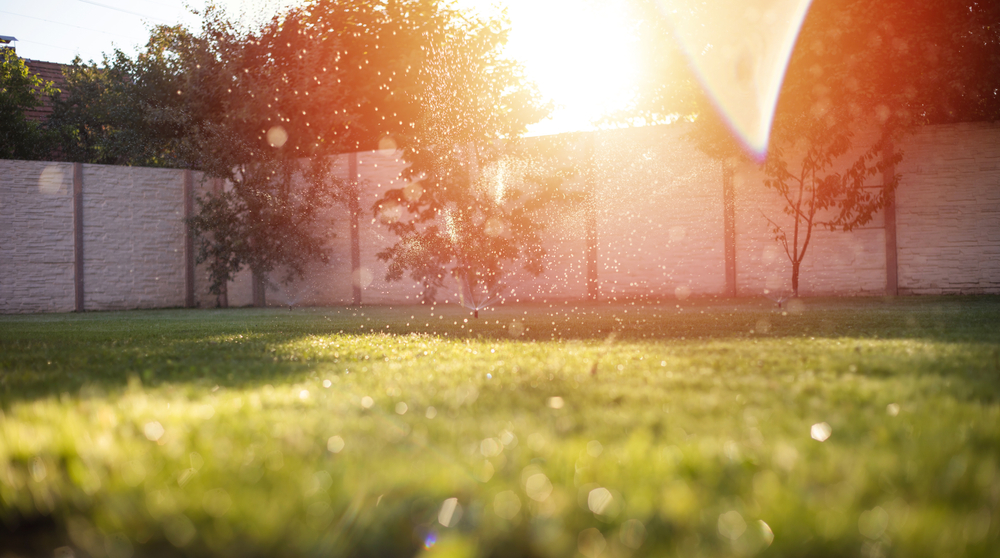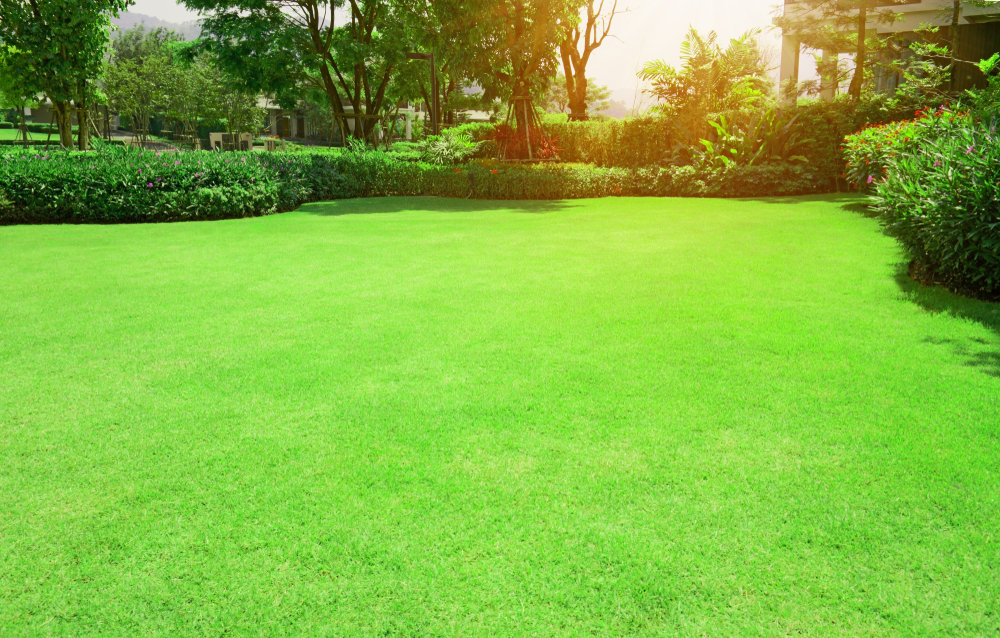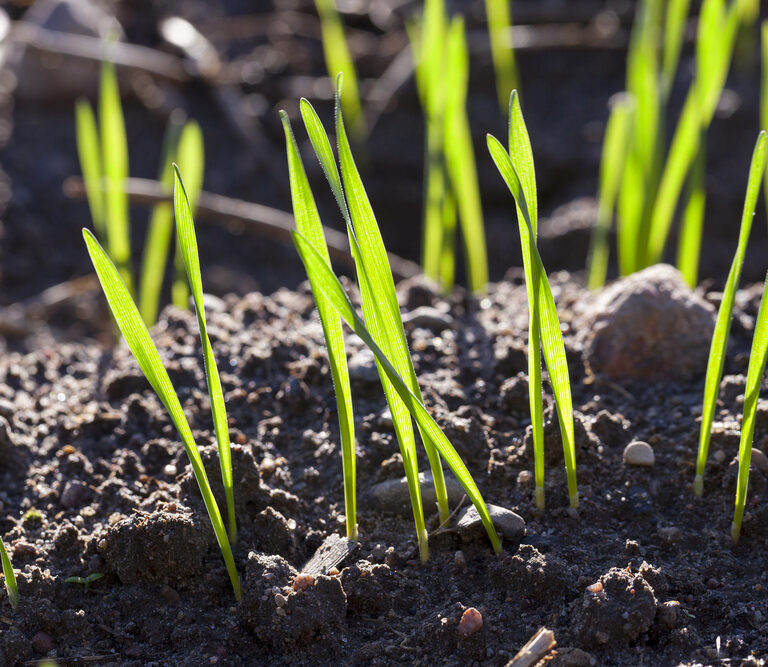Generally speaking, grass takes between 7 and 30 days to begin growing, but those numbers are massively dependent on a lot of factors, including the time of year, what type of seed you have and how well you look after it.
In this guide, we’ve unpacked those factors and brought you some top tips for sprouting the most luscious lawn you’ve ever seen. We’ll soon have you growing more grass than your trendy local pharmacist.
Types of Grass Seeds – and How Long It Takes These Grass Seeds to Grow
Different grass seeds have different germination periods, so you should always check the expected germination period for whatever type of grass you’re growing. Here are some common types of grasses along with their germination periods:
- Annual Ryegrass: 5-10 days
- Bentgrass: around 14 days
- Bermuda Grass: 10-30 days
- Buffalo Grass: 14-30 days
- Centipede Grass: 14-21 days
- Kentucky Bluegrass: 10-21 days
- Perennial Ryegrass: 5-7 days
- Red Fescue: 12-22 days
- Tall Fescue: 7-10 days
- Zoysia: 14-21 days
These are the most common grass types, but others exist too. If you’re trying to work out what type of grass you already have lurking around on your lawn, here’s a good guide:
As you’ll have noticed from that video, some types of grasses are warm-weather grasses, while some types of grasses are cold-weather grasses. Grasses perform best under the conditions which are best suited to them, and seeds should therefore be planted accordingly.
Generally speaking, cold-weather grasses grow quicker, because they need less warmth and less sun, so they’re not so reliant upon having optimum conditions at all times. That said, you should still buy grass which matches up with whatever type of climate you live in – and whatever type of year it is.
Broadly, cold-weather grasses grow best in air temperatures of around 60-75 degrees Fahrenheit, while warm-weather grasses grow best in temperatures above 80 degrees Fahrenheit.
When daytime temperatures are around 55 degrees Fahrenheit, don’t bother planting any grass seeds, even the cold-weather ones. They probably won’t grow.
If you live in a place with a climate which varies around the year, time your planting accordingly. Generally, you should plant your cold-weather seeds in fall or early winter, and your warm-weather seeds in spring or early summer. If there’s any good chance of frost in the next 60-90 days, don’t plant warm-weather grass seeds – they won’t be able to handle the coming cold.
If you follow the rules above, you’re on your way to swiftly-growing grass.
Germination vs. Growing
It’s important to remember that germination is a massively different thing from having a full, lush lawn. Germination time reflects how long it’ll be before you start seeing a good amount of grass. But there’ll be a long period between those humble beginnings and a fully-fledged, jealousy-inducing lawn.
So how does germination rate relate to growing rate?
Normally, for a fully-fledged lawn, you’ll need to wait up to a full year, no matter what type of grass you’re growing.
Generally speaking, your grass will probably be ready for its first cut around 2-3 months after you’ve planted your seeds. At this point, it’ll look great, and you’ll probably be surprised by how much progress you’ll have made. But it’ll then take another 7-8 months for your lawn to be at its peak. And as long as you look after it, it should then stay that way for a long while.
If you want your grass to grow well, you need to treat it right. You need to consider your soil, your feed, your water and your weather, even before you plant your seeds. First up, you need to prepare your soil…
How to Prepare Your Soil for Some Seeds
Seeds need good soil. If you give them it, they’ll gratefully grow with vigor you never thought possible. Here’s how to do it:
- Get rid of weeds. If you can, kill these weeds naturally, but use chemical weed removers if you really need to. If you do use chemical weed removers, you’ll need to wait a little while before planting. Consult the packaging to check how long you should wait.
- Add around 1 or 2 inches of fresh, good-quality compost. If you get very good compost, there’s more chance that your seeds will grow in the way you want them to. After you’ve added your compost, do some raking and remove any rocks and debris.
- Water your soil before you plant your seeds. You want to make sure the soil is somewhere between moist and damp. Water it for a few days before you plant your seeds. You don’t want it to be too dry or too spongy.
It’s also important to know what type of soil you have. All soils have different levels of nutrients and acidity, which affect whether or not you might need to treat or prepare your soil before you even consider planting seeds. Use a soil testing kit if you’re unsure.
If you prepare your soil in the right way, you’re giving your seeds an excellent base for speedy growth.
The Key Things to Consider for Good Grass Growth

If you want fast-growing grass, you have to give your grass good light, good food and good water. Here’s how:
Sun
Sun is (obviously) important. If your planned grass-planting land doesn’t receive around 6 or more hours of direct sunlight a day, it’s never going to grow in the way you want it to.
Water
Water is important too. Use a sprinkler to water your seeds every day, but don’t over-saturate. If you see any pooling, stop watering. Generally speaking, you should water your seeds 4 times a day, for 15 minutes at a time for the first two weeks after you’ve planted them.
For the next week, water for about 40 minutes per day, once a day. After a week, reduce to around 40 minutes of watering every other day. After another week, reduce to around 40 minutes of watering a day, three times a week.
Obviously, if you’re getting a lot of rain, adapt your watering routine slightly. If you’re having big downpours, you might not need to water your grass at all. If you’re only having showers, you’ll probably only need to reduce your watering a little.
Food
You’ve got your sun, you’ve got your water, now let’s give those precious seeds another little helping hand. Buy some high-quality food that’s suitable for the type of grass you’re growing. Generally, something like this is great.
Top Tips for Good Grass Growth
If you’re looking for good grass growth hacks, we’ve got some of them too. Here are our favorites:
- Before you begin, speak to an expert at your local nursery. They can give you bespoke advice according to where you live, and what time of year it is. No matter how much you think you know, this is always a good idea.
- If you want really even grass, consider using a good grass seed spreader.
- When you’re buying your seeds, buy fresh seeds. If they were bagged within the last couple of years, that’s good, but anything longer isn’t ideal. Check the bags for dates, and buy the freshest seeds you possibly can.
- Plant seeds around ¼” into the soil, or a little more. If you plant too deep, they might not push through. If you plant too shallow, they might not root.
- Once your grass is growing consistently and quickly, mow it routinely. Overgrown grass can end up dying and getting damaged. If you’re new to mowing lawns, here are some top tips on how to do it properly.
When Should I Mow My New Grass?

You should give your grass its first mowing session when it first reaches a height of around 4 inches. Before then, your grass might not be mature enough to withstand a mowing, so be patient, or you might sabotage all your hard work. After that first cut, you can then cut your grass whenever and as often as you like. Again, it’s good to do it routinely, to keep your grass healthy and tidy.
Final Thoughts
Overall, the most important factor in speedy grass growth is taking good care of it. If you follow the tips above, your grass will grow as quickly as it possibly can. If you’re starting today, you’ll have a great lawn a few months from now, and an incredible lawn a year from now. Happy growing, happy mowing.
